 Libri di Susan M. Gass su Unilibro.it) Libri di Susan M. Gass su Unilibro.it)
|
|
1919 |
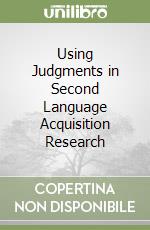 Title :
Using Judgments in Second Language Acquisition Research
Title :
Using Judgments in Second Language Acquisition ResearchAuthor: Spinner Patti, Gass Susan M. Publisher: Routledge € 144,90
|
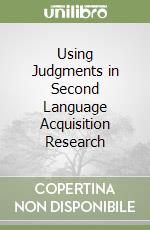 Title :
Using Judgments in Second Language Acquisition Research
Title :
Using Judgments in Second Language Acquisition ResearchAuthor: Spinner Patti, Gass Susan M. Publisher: Routledge € 46,80
|
|
1917 |
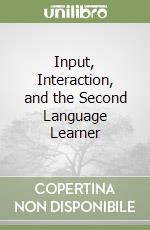 Title :
Input, Interaction, and the Second Language Learner
Title :
Input, Interaction, and the Second Language LearnerAuthor: Gass Susan M. Publisher: Routledge € 130,90
|
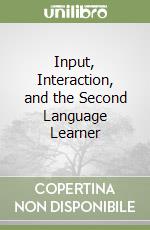 Title :
Input, Interaction, and the Second Language Learner
Title :
Input, Interaction, and the Second Language LearnerAuthor: Gass Susan M. Publisher: Routledge € 52,40
|
 Title :
Salience in Second Language Acquisition
Title :
Salience in Second Language AcquisitionAuthor: Gass Susan M. (EDT), Spinner Patti (EDT), Behney Jennifer (EDT) Publisher: Routledge € 140,30
|
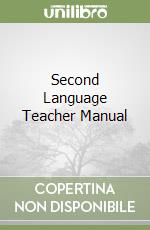 Title :
Second Language Teacher Manual
Title :
Second Language Teacher ManualAuthor: Gass Susan M. Publisher: Routledge € 209,60
|
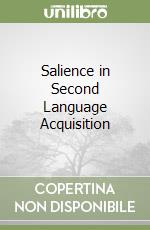 Title :
Salience in Second Language Acquisition
Title :
Salience in Second Language AcquisitionAuthor: Gass Susan M. (EDT), Spinner Patti (EDT), Behney Jennifer (EDT) Publisher: Routledge € 39,30
|
|
|
1916 |
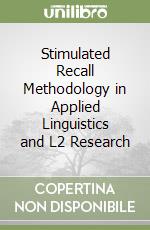 Title :
Stimulated Recall Methodology in Applied Linguistics and L2 Research
Title :
Stimulated Recall Methodology in Applied Linguistics and L2 ResearchAuthor: Gass Susan M., Mackey Alison Publisher: Routledge € 149,60
|
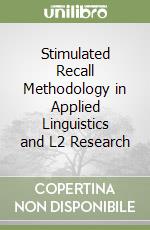 Title :
Stimulated Recall Methodology in Applied Linguistics and L2 Research
Title :
Stimulated Recall Methodology in Applied Linguistics and L2 ResearchAuthor: Gass Susan M., Mackey Alison Publisher: Routledge € 50,50
|
|
1915 |
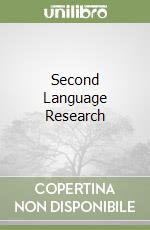 Title :
Second Language Research
Title :
Second Language ResearchAuthor: Mackey Alison, Gass Susan M. Publisher: Routledge In this second edition of the best-selling Second Language Research, Alison Mackey and Sue Gass continue to guide students step-by-step through conducting the second language research process with a clear and comprehensive overview of the core issues in second language research. Supported by a wealth of data examples from actual studies, the book examines questions of what is meant by research and what defines good research questions, covering such topics as basic research principles and data collection methods, designing a quantitative research study, and concluding and reporting research findings. The second edition includes a new chapter on mixed-methods, new "time to think" and "time to do" text boxes throughout, and updates to reflect the latest research and literature. Supplementary materials, including an extensive glossary and appendices of forms and documents that students can use in conducting their own studies, serve as useful reference tools, with suggestions on how to get research published reemphasizing the book’s practical how-to approach. Second Language Research, Second Editionis the ideal resource for understanding the second language research process for graduate students in Second Language Acquisition and Applied Linguistics. € 243,10
|
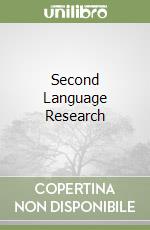 Title :
Second Language Research
Title :
Second Language ResearchAuthor: Mackey Alison, Gass Susan M. Publisher: Routledge € 95,60
|
|
1913 |
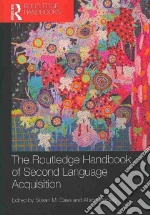 Title :
The Routledge Handbook of Second Language Acquisition
Title :
The Routledge Handbook of Second Language AcquisitionAuthor: Gass Susan M. (EDT), Mackey Alison (EDT) Publisher: Routledge The Routledge Handbook of Second Language Acquisition brings together fifty leading international figures in the field to produce a state-of-the-art overview of Second Language Acquisition. The Handbook covers a wide range of topics related to Second Language Acquisition: language in context, linguistic, psycholinguistic, and neurolinguistic theories and perspectives, skill learning, individual differences, L2 learning settings, and language assessment. All chapters introduce the reader to the topic, outline the core issues, then explore the pedagogical application of research in the area and possible future development. The Routledge Handbook of Second Language Acquisition is an essential resource for all those studying and researching Second Language Acquisition. € 68,30
|
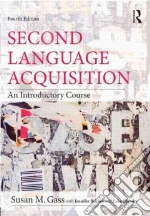 Title :
Second Language Acquisition
Title :
Second Language AcquisitionAuthor: Gass Susan M., Behney Jennifer (CON), Plonsky Luke (CON) Publisher: ROUTLEDGE Now in a fourth edition, this bestselling introductory textbook remains the cornerstone volume for the study of second language acquisition (SLA). Its chapters have been fully updated, and reorganized where appropriate, to provide a comprehensive yet accessible overview of the field and its related disciplines. To reflect current developments, new sections on using learner corpora, semantics and morphosyntax (within formal approaches to SLA), sociocultural approaches, gesture, priming research, and chaos theory have been added. Students will also find expanded discussions of heritage language learning, bilingualism, pragmatics, and much more. The redesigned fourth edition of Second Language Acquisition retains the features that students found useful in the current edition but also provides new pedagogical tools that encourage students to reflect upon the experiences of second language learners. As with previous editions, discussion questions and problems at the end of each chapter help students apply their knowledge, and a glossary defines and reinforces must-know terminology. This clearly-written, comprehensive, and current textbook, by expert Sue Gass, is the ideal textbook for the introductory SLA course in second language studies, applied linguistics, linguistics, TESOL, and language education programs. € 59,80
|
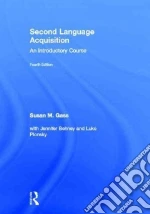 Title :
Second Language Acquisition
Title :
Second Language AcquisitionAuthor: Gass Susan M., Behney Jennifer (CON), Plonsky Luke (CON) Publisher: Routledge Now in a fourth edition, this bestselling introductory textbook remains the cornerstone volume for the study of second language acquisition (SLA). Its chapters have been fully updated, and reorganized where appropriate, to provide a comprehensive yet accessible overview of the field and its related disciplines. To reflect current developments, new sections on using learner corpora, semantics and morphosyntax (within formal approaches to SLA), sociocultural approaches, gesture, priming research, and chaos theory have been added. Students will also find expanded discussions of heritage language learning, bilingualism, pragmatics, and much more. The redesigned fourth edition of Second Language Acquisition retains the features that students found useful in the current edition but also provides new pedagogical tools that encourage students to reflect upon the experiences of second language learners. As with previous editions, discussion questions and problems at the end of each chapter help students apply their knowledge, and a glossary defines and reinforces must-know terminology. This clearly-written, comprehensive, and current textbook, by expert Sue Gass, is the ideal textbook for the introductory SLA course in second language studies, applied linguistics, linguistics, TESOL, and language education programs. € 157,10
|
|
1911 |
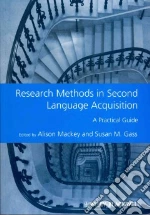 Title :
Research Methods in Second Language Acquisition
Title :
Research Methods in Second Language AcquisitionAuthor: Mackey Alison (EDT), Gass Susan M. (EDT) Publisher: Blackwell Pub Research Methods in Second Language Acquisition: A Practical Guideis an informative guide to research design and methodology for graduate students and scholars. Each chapter of this volume offers background, step-by-step guidance, and relevant studies to create comprehensive coverage of each method.
€ 37,30
|
|
|
2007 |
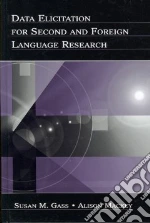 Title :
Data Elicitation for Second and Foreign Language Research
Title :
Data Elicitation for Second and Foreign Language ResearchAuthor: Gass Susan M., Mackey Alison Publisher: Taylor & Francis This timely reference guide is specifically directed toward the needs of second language researchers, who can expect to gain a clearer understanding of which techniques may be most appropriate and fruitful in given research domains. Data Elicitation for Second and Foreign Language Research is a perfect companion to the same author team’s bestselling Second Language Research: Methodology and Design. It is an indispensable text for graduate or advanced-level undergraduate students who are beginning research projects in the fields of applied linguistics, second language acquisition, and TESOL as well as a comprehensive reference for more seasoned researchers. € 130,90
|
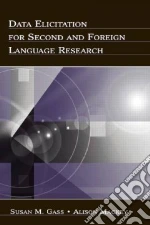 Title :
Data Elicitation for Second and Foreign Language Research
Title :
Data Elicitation for Second and Foreign Language ResearchAuthor: Gass Susan M., Mackey Alison Publisher: Routledge This timely reference guide is specifically directed toward the needs of second language researchers, who can expect to gain a clearer understanding of which techniques may be most appropriate and fruitful in given research domains. Data Elicitation for Second and Foreign Language Research is a perfect companion to the same author team’s bestselling Second Language Research: Methodology and Design. It is an indispensable text for graduate or advanced-level undergraduate students who are beginning research projects in the fields of applied linguistics, second language acquisition, and TESOL as well as a comprehensive reference for more seasoned researchers. € 51,00
|
|
2004 |
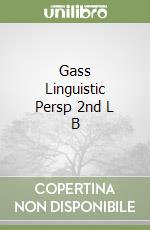 Title :
Gass Linguistic Persp 2nd L B
Title :
Gass Linguistic Persp 2nd L BAuthor: Susan M. Gass Publisher: BERTRAMS PRINT ON DEMAND This volume explores how a second language is acquired and what learners must do in order to achieve proficiency. The paperback edition is a collection of original essays that approaches second language acquisition from a linguistic rather than a sociological, psychological, or purely pedagogical perspective. A wide range of viewpoints and approaches is represented. However, all authors agree on the fundamental importance of linguistic theory in the study of second language acquisition. Few works have explored in depth how a second language is acquired and what the second language learner must do mentally to achieve proficiency in another language. The essays in this book provide an incisive analysis of these questions. For greater accessibility, the chapters are arranged topically from those covering the broad area of theories of acquisition to those focusing specifically on syntax, semantics, pragmatics, lexicon, and phonology in another language. € 48,25
|
|
|
1998 |
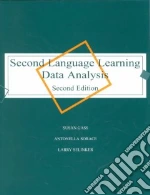 Title :
Second Language Learning Data Analysis
Title :
Second Language Learning Data AnalysisAuthor: Gass Susan M., Sorace Antonella, Selinker Larry Publisher: Routledge The purpose of this workbook is to provide students with practice in analyzing second language data. For the student of second language learning, "hands-on" experience with actual data is essential in understanding the processes involved in learning a second language. Working through exemplars of the kinds of interlanguages that learners do and do not create brings about a clearer understanding of the principles underlying these interlanguages, as well as the universal principles of language learning (those that are independent of particular languages and interlanguages). The goal in this workbook is to present data organized in such a way that by working through pedagogically presented data-sets, students are led to a discovery and understanding of theoretical and/or methodological issues. In addition, they acquire the ability to interpret data and to begin to draw conclusions from them. The authors intend that students should go from the data to a conclusion that includes a 3-part statement: *what else you should want to know about these data; *why this, specifically, and not something else; and *how one can empirically research what you want to find out. This sequence of questions forces students to constantly keep in mind the important question of falsification: What kind of data would it take to falsify the particular conclusions the students come to? As with the earlier edition of this workbook (Sorace, Gass, & Selinker), two audiocassettes provide language samples for use in the exercises. These cassettes and the teacher's manual are offered free of charge on adoption of the workbook for classroom use; a three-part set (workbook/manual/tapes) is also available. € 41,10
|
|